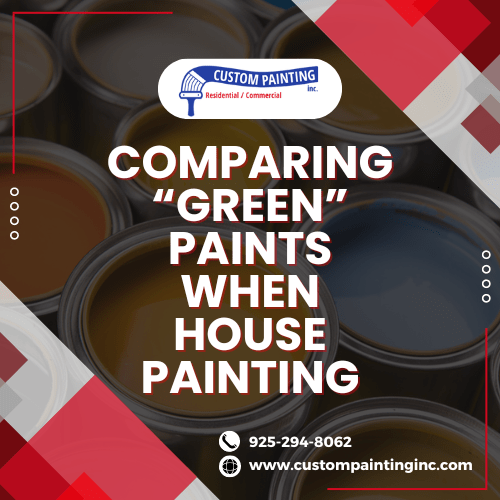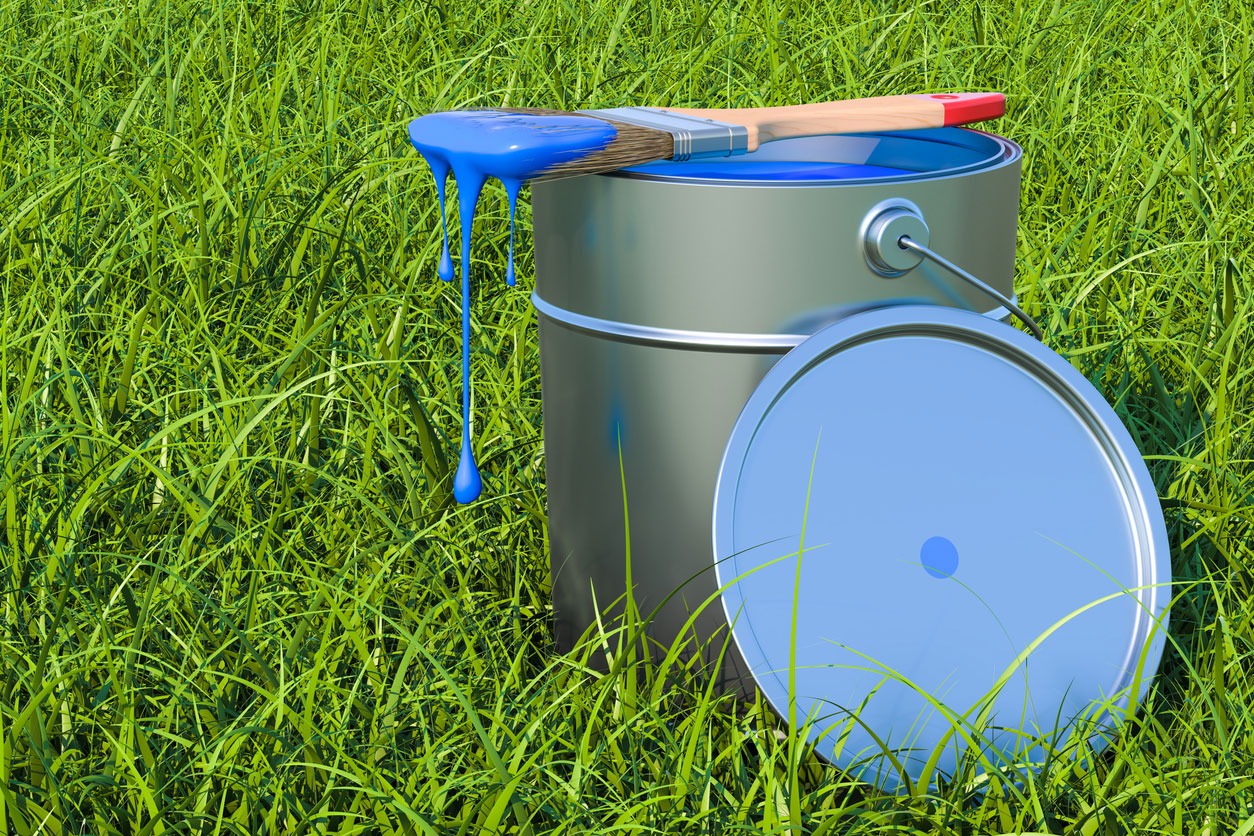People are more aware of how their actions can impact the environment, including house painting. If you’re one of those people, you are likely using environmentally friendly or “green” paints or would like to purchase one.
As the concern for environmental sustainability has grown in recent years, people have begun to adopt environmentally friendly painting practices. Of course, many paint manufacturers have also “gone green” by introducing eco-friendly paint options to the market, which this article explores.
What are “traditional paints,” and what do they contain?
Traditional paints dominate the market. These products usually contain the following:
- Solvents – Traditional paints often use volatile organic compounds (VOCs) as solvents. VOCs are chemicals that evaporate into the air during paint application and drying.
- Binders – Synthetic binders like acrylic, alkyd, and epoxy are commonly used. These provide adhesion, durability, and chemical resistance.
- Pigments – Synthetic pigments, including heavy metals like lead and cadmium, have been used historically, although their use is now regulated.
- Additives – Various chemical additives improve paint’s properties, such as drying time, mildew resistance, and shelf life.
Here are the VOCs that traditional paints usually have:
- Acetone
- Toluene
- Xylene
- Benzene
- Trichloroethylene
- Propylene glycol
- Styrene
- Glycol ethers
- Ethanol
- Dichloromethane
- Formaldehyde
While VOCs are significant, they are not the only determinants of a paint’s environmental friendliness (or harmfulness). Other ingredients that make traditional paints less safe and eco-friendly include:
1. Biocides are ingredients that kill harmful bacteria. Biocides are essential because they prevent the growth of harmful organisms, prolonging the paint’s life. Examples of biocides in paint include:
- Fungicides specifically target fungi like mold and mildew.
- Algaecides prevent algae growth, which is a common problem on exterior surfaces.
- Bactericides target bacteria that may cause paint contamination or degradation.
However, biocides can also raise health and environmental concerns. Some biocides are toxic to humans, animals, plants, and other living organisms. Many regions have imposed regulations to control the use and disposal of biocides to mitigate their environmental impact.
2. Phthalates are a group of chemical compounds commonly used as plasticizers (substances added to plastics to increase their flexibility, transparency, durability, and longevity). Phthalates give the paints flexibility, durability, stability, and ease of application.
However, they can cause various health and environmental risks. Certain phthalates may also have carcinogenic effects. Due to these concerns, there is increasing regulation on the use of phthalates in paints and other consumer products.
3. Vinyl chloride is used to generate polyvinyl chloride (PVC), a versatile plastic. In paints, it is used indirectly by producing vinyl chloride copolymers.
Vinyl chloride copolymers form a durable film that provides excellent protection to the substrate. They also improve paint adhesion and provide elasticity, flexibility, and resistance to the elements. Vinyl chloride monomer is a known carcinogen that can pose serious health risks if inhaled, although its polymerized form is generally considered safe for use. However, exposure control is still necessary to mitigate its health risks.
Vinyl chloride can also cause environmental hazards. Proper disposal and recycling of paints and other vinyl chloride products are crucial to mitigate their environmental impact.
What makes paint “green” or environmentally friendly?
“Green” house paints are considered environmentally friendly due to several key factors:
- Low or zero VOCs – Traditional paints contain VOCs that release harmful chemicals into the air as they dry. Green paints have low or no VOCs, reducing air pollution and health risks.
- Natural ingredients – “Green” paints use natural, non-toxic ingredients instead of synthetic chemicals. Common natural ingredients include water, plant oils, and minerals.
- Sustainable manufacturing – The production process of green paints often involves sustainable practices, such as using renewable energy and reducing waste.
- Biodegradability – Green paints are formulated as biodegradable. It means these paints break down naturally without damaging the environment.
- Recycled content – Some green paints incorporate recycled materials, reducing the demand for new raw materials and minimizing waste.
- Certifications – Many green paints are certified by environmental standards organizations (e.g., LEED, Green Seal), ensuring they meet specific environmental and health criteria.
How can you tell if the paint is “green”?
Many paint manufacturers don’t display a detailed list of ingredients on their labels. It makes identifying what’s in a paint product challenging (and often frustrating). Even looking at the product’s datasheet won’t provide such information.
However, there are still ways that can help you determine if a paint is “green or environmentally friendly. Consider the following key indicators:
- Low or zero VOCs – VOCs are harmful chemicals that can off-gas from paint. Look for products labeled as low-VOC or zero-VOC.
- Eco-certifications – Check for certifications from reputable organizations. Some common eco-labels for paints include:
- Green Seal
- GREENGUARD
- LEED (Leadership in Energy and Environmental Design)
- ECOLOGO
- Natural ingredients – Some green paints contain natural ingredients like plant oils, minerals, and other non-toxic materials. Look for ingredient lists that highlight these components.
- Low odor – Eco-friendly paints often have low or no odor compared to conventional paints due to the absence of harsh chemicals.
- Recycled content – Some paints include recycled materials, which can reduce the environmental impact of production.
- Manufacturer’s environmental policies – Check the manufacturer’s commitment to sustainability, including their production processes, packaging, and corporate social responsibility initiatives.
- Durability and coverage – High-quality green paints should provide good coverage and durability, reducing the need for frequent repainting, which reduces waste.
- Water-based – Water-based (latex) paints are generally more environmentally friendly than oil-based paints. They emit fewer VOCs and are easier to clean up without harmful solvents.
Natural paints
Suppose you are looking for safe paints for your health and the environment. Choose natural paints. They are eco-friendly alternatives to traditional paints made from natural ingredients without synthetic chemicals or VOCs. Here are some examples of natural paints for home use:
1. Milk paint
Ingredients: Casein (milk protein), lime, and natural pigments.
Characteristics: Non-toxic, biodegradable, and has a matte, rustic finish.
2. Clay paint
Ingredients: Clay, chalk, and natural pigments.
Characteristics: Breathable, regulates humidity, and gives a soft, earthy appearance.
3. Limewash
Ingredients: Slaked lime and water, sometimes with natural pigments.
Characteristics: Antibacterial, breathable, and has a unique, aged look.
4. Plant-based paints
Ingredients: Plant oils (like linseed or citrus oil), resins, natural pigments.
Characteristics: Durable, low odor, and various finishes (matte, satin, etc.).
5. Mineral paints
Ingredients: Mineral-based materials such as silicate or clay.
Characteristics: Breathable, long-lasting, and good for masonry surfaces.
6. Beeswax paints
Ingredients: Beeswax, tree resins, and natural pigments.
Characteristics: Water-resistant, smooth finish, and pleasant natural scent.
These paints are ideal for people looking to reduce their environmental impact and create healthier indoor air quality.
As for cost, natural paints are a little more expensive than traditional paints, but not prohibitively. They’re also tricky to find in physical stores, making it much easier to find online.
Parting words
Switching to “green” paints can be beneficial for environmental and health reasons. Evaluate the costs, performance, certifications, and your home’s or business’s needs before making your decision. Balancing these factors will help ensure that the switch is sustainable and practical.
Whatever “green” paint you decide to use, remember that you are welcome to discuss it with our professionals at Custom Painting, Inc. Our team can provide you with recommendations for “green” paints for a safer, healthier, and more beautiful home. Call us at 925-294-8062 or complete our contact form to learn more about services or request a job estimate.


